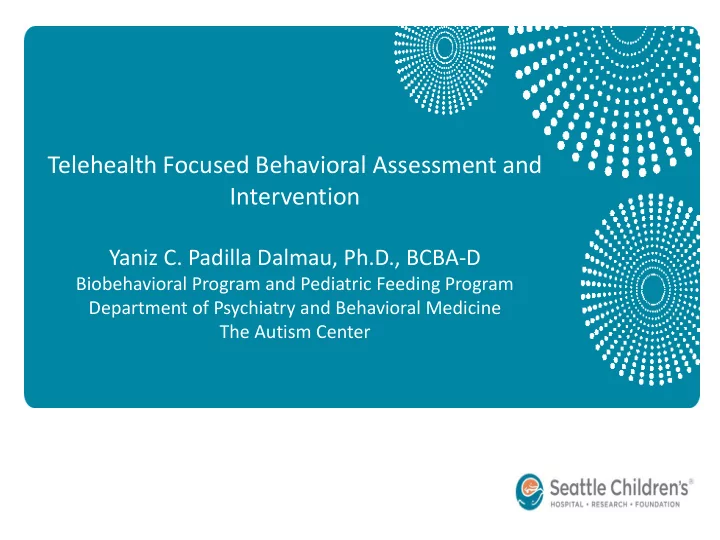

Telehealth Focused Behavioral Assessment and Intervention Yaniz C. Padilla Dalmau, Ph.D., BCBA-D Biobehavioral Program and Pediatric Feeding Program Department of Psychiatry and Behavioral Medicine The Autism Center
ABA Telehealth Service Models • Synchronous Parent coaching – Clinic to clinic (research and practice) – Clinic to home (research and practice) – Home to home (practice/COVID19 crisis) • Synchronous Supervision – Clinic to home, RBT supervision (practice) • Train the trainer models – Remote Behavior Skills Training of providers through telehealth
ABA Telehealth Service Models • Research Support: – Behavioral Assessment (Barreto et al., 2006; Lindgren et al., 2016; Machalicek et al., 2009, 2012, 2016; Wacker et al., 2013a, Suess et al., 2016) – Behavioral Intervention (Gibson et al., 2010; Lindgren et al., 2016; Machalicek et al., 2016, Suess et al., 2014; Wacker et al., 2013b, Suess et al., 2016) – Feeding follow-up in the home after intensive (Peterson et al., 2017) – Results: Effective implementation, high integrity, high parent acceptability, lower costs, higher efficiency – Parents and behavioral technicians can be taught how to implement behavioral assessments and interventions effectively via telehealth (Wacker et al., 2013a, Wacker et al., 2013b, Fisher et al., 2014). • Recent COVID-19 related resources – Council of Autism Service Providers (2020). Practice Parameters for Telehealth- Implementation of Applied Behavior Analysis: Continuity of Care during COVID-19 Pandemic. Wakefield, MA: Author. – Lerman , D, O’Brien, M. & Neely, L. et al., (2020) &Call, Nathan & Tsami, Loukia & Schieltz, Kelly & Berg. Remote Coaching of Caregivers via Telehealth: Challenges and Potential Solutions. Journal of Behavioral Education. 10.1007/s10864-020-09378-2.
WABA Question Areas • Overview of how to conduct telehealth • Data collected during telehealth visits • Methods of training
Parent Coaching Model Overview Behavior Analyst / Telehealth Psychologist (Remote) Parent/Child Parent/Child In Person in home in clinic (Originating)
Parent Coaching Model Overview Clinic to Clinic Clinic to Home/Home to Home • Considerations/ Determine type of service model • Process Client appropriateness/Safety • Staff Training and Credentialing • HIPAA and Technology Selection • Funding and Services • Develop Workflows • Informed Consent Relevant Ethical Codes Professional and Ethical Compliance Code for Behavior Analysts(BACB, 2016) Ethical Principles of Psychologists and Code of Conduct (APA, 2010) Guidelines for the Practice of Telepsychology (APA, 2013)
Parent Coaching Model Overview Clinic to Clinic Clinic to Home/Home to Home Originating Regional Clinics Child’s Home, Schools, Parents could Site consult from work • Originating Video teleconferencing Existing family technology and internet Site (VTC) hardware (i.e., provider. Blue Jeans application technology video camera, television originally. Most recently InTouch and monitor) Zoom. • Families receive secure link to their emails. • Integration with existing systems. Hospital VTC hardware on rolling Desktop computers , iPads, etc. Device Site/Provider cart or stationary VTC agnostic. Blue Jeans/InTouch/Zoom. side For home-to-home: provider hardware, technology InTouch and Zoom with back ups as needed.
Parent Coaching Model Overview Clinic to clinic Clinic to home Target Population Children with developmental disabilities with challenging behavior and children with pediatric feeding disorders Service model Once per week Twice per week Monthly follow-up Step up and down from more intensive models (generalization to new settings) New visits Safety Screened the clinical spaces for Developed structured screening safety prior to starting services in process and safety assessment each regional clinic Participants in Parent, patient, medical assistants Parent, patient. Sometimes local Originating Site or nurses providers, BCBAs, teachers, teacher assistants, etc. Participants in Licensed Psychologists BCBA-D, Licensed Psychologists BCBA-D, Hospital/Remote Dietitian BCBAs. With COVID crisis, dietitians, Site SLP
Parent Coaching Model Overview Considerations Relevant ethical guidelines and tips Client Examine potential PRACTICE TIPS: risks/benefits, client 1. Establish criteria for clients to be seen remotely Appropriateness/ preference, distance, safety (e.g., distance criteria, safety criteria, Safety preference) 2. Conduct safety screenings of clients site: home, community, or clinic 3. Establish a safety screener to evaluate risk/benefit 4. Write a crisis plan that includes a phone number to contact if the connection is lost and local emergency contacts (e.g., local police, PCP, med provider). Have readily available for in- home/community locations 5. Continuously reevaluate safety and appropriateness of model for the patient
Parent Coaching Model Overview
Parent Coaching Model Overview Clinic to home/home to home • Typical Session 5-10 minute reviewing parent data and updates on treatment implementation Structure • 5-10 minutes. Provider outlines procedures to be implemented. This (60 min sessions) can include a protocol provided prior to session. • 30-40 minutes. With coaching, parent implements treatment sessions while BCBA coaches and collects data remotely. • 5-10 minutes. BCBA reviews results of session, provides assignment to parent for next session. • After session: BCBA graphs data, updates protocols/data sheets and sends to parent as needed. *Session can be 60-90 minutes • Didactic/Written instructions: protocols, cheat sheets Parent Coaching • Immediate feedback: through speakers or bug-in-the ear Strategies • Role Play/Modeling as needed
Parent Coaching Model Overview Clinic to home/home to home • Goals/Data The same goals and data collected as in-person sessions. • Can include child data: trial-based data, rate of behavior, frequency, Collected duration, partial-interval data, etc. Examples: - Biobehavioral clients we often report percent reduction of target behavior from a functional analysis baseline. - Pediatric feeding patients, we often report percentage of trials consumed of a specific target food, increased novel foods tried, decreases in food refusal
Additional questions? Questions? Yaniz.padilladalmau@seattlechildrens.org
Recommend
More recommend